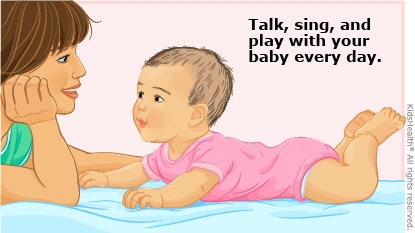To communicate means to share thoughts, ideas, and feelings. We communicate through sounds, words, facial expressions, and touch. Babies this age can communicate through body language, smiles, laughter, crying, and babbling. Talking, singing, and touching your baby all strengthen the bond between you and help your baby learn to communicate.



You know your baby best. If your baby has signs that concern you, call your health care provider.

How do babies this age communicate? Babies this age use sounds to get attention and show feelings. Their voices might get higher, as if asking a question. Babies also use body language to communicate. When full, your baby might lean back and turn away to let you know not to give more food. Your baby may show excitement by smiling and moving when you come into the room.
When do babies start to understand what words mean? By the end of the seventh month, babies usually respond to their names, pause when they hear "no," babble, copy sounds, and respond to speech by making sounds of their own.